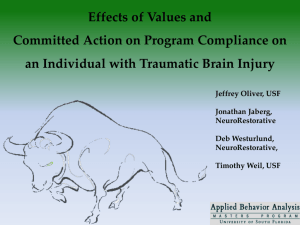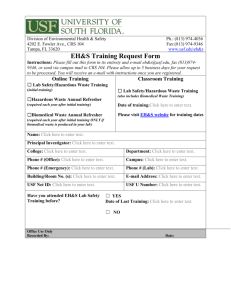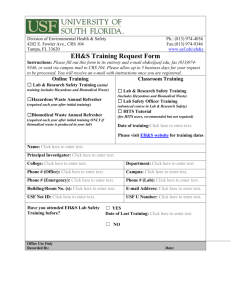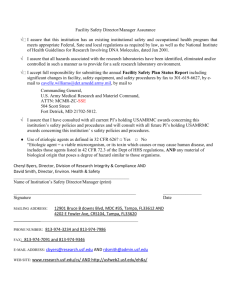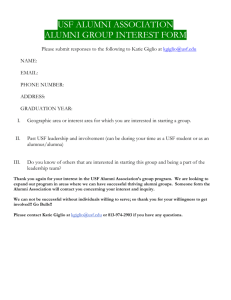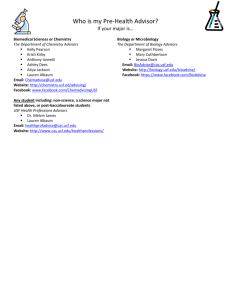presentation - University of South Florida
advertisement
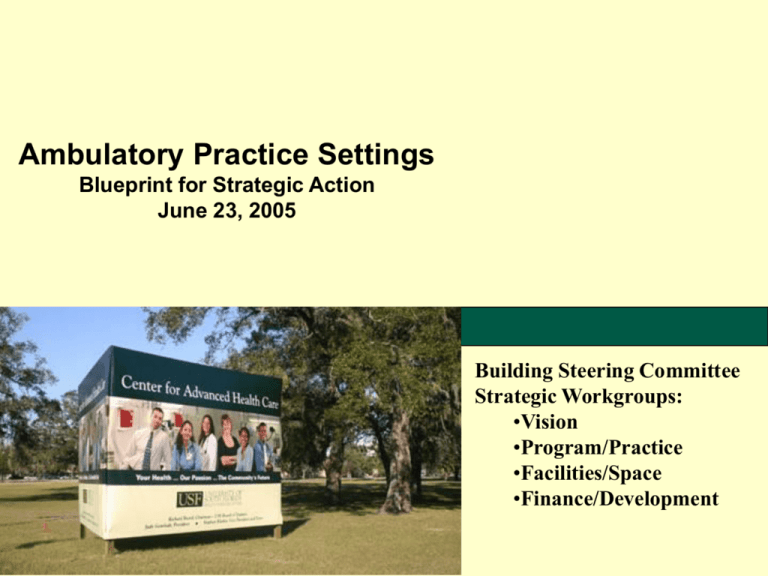
Ambulatory Practice Settings Blueprint for Strategic Action June 23, 2005 Building Steering Committee Strategic Workgroups: •Vision •Program/Practice •Facilities/Space •Finance/Development Blueprint for Strategic Action “Strive for national prominence through excellence, professionalism Creative Educational Models • Develop practice-ready students who “get it” • Joint degrees for emerging workforce • 3rd / 4th year curriculum • Outcomes-based education and training • Service learning and community outreach Entrepreneurial Academic Model • Creative/successful practice and outreach models • New strategic models for clinical sites, community partners: e.g. TGH, HLM, VA, ACH, outpatient teaching sites diversity, timeliness and strategic growth.” National Prominence Excellence Educationally superior Technologically superior Build superior patient safety, access and outcomes Put us on the map Unique collaboration across health disciplines Research Really Matters • Hire world class teams • Big ideas, research cores and teams: e.g., Cell therapy, homeland defense, biotech • Measure quality and productivity • Goal: Top 50 public research universities True Integration: COM + HSC + University • Interdisciplinary across departments, colleges, university • Opportunities: Research cores, engineering, technology, international, MD/MBA, bioengineering, bioinformatics Agenda 1. 2. 3. 4. 5. Goals Vision Current Concept Critical Success factors Parallel Processes • • • • Facility Design/Construction Program Planning Technology Finance 6. Committees & teams Goals of the Discussion • To review the current CAHC concept and ensure understanding of the vision, and develop some guiding principles to continue planning • To develop an understanding of the tight timetables in which to develop the CAHCs • To develop an efficient and defined decision making process that ensures the inclusion of the necessary constituents and achieves the demanding project timetable • To solicit and discuss all ideas as they relate to the CAHC USF Center for Advanced Health Care Mission: To provide the most advanced care for our community in a model center for learning. Vision: To create within three years a national showcase for health care, featuring service and safety for patients, team care supported by advanced technology, demonstrable health improvements for the community, and superior education. “My vision for this building is simple: It will be the place where quality, technology and service combine to create a national model of excellence. When you look at the directory you will notice not a list of specialties but a multidisciplinary level of service that will be patient friendly and allow us to transform the education of our students.” -Stephen Klasko USF Health: Leading the Quality Revolution Goal: To lead, develop and teach the quality/service revolution • AAMC Institute for Improving Clinical Care: “Key among those concerns is whether the current health care delivery systems of academic health centers provide learning environments for the clinical education of tomorrow’s doctors that incorporate the highest quality patient care.” • AAMC Academic Chronic Care Collaborative: Leading health systems have tackled the “transformation of healthcare from a system that is essentially reactive—responding mainly when a patient is sick—to one that is proactive and focused on keeping a person as healthy and functional as possible.” “Few of these have been academic settings with integral involvement of residents and other health professions students.” USF Health: Leading the Quality Revolution Goal: To lead, develop and teach the quality/service revolution • AAMC Institute for Improving Clinical Care: “Key among those concerns is whether the current health care delivery systems of academic health centers provide learning environments for the clinical education of tomorrow’s doctors that incorporate the highest quality patient care.” • AAMC Academic Chronic Care Collaborative: Leading health systems have tackled the “transformation of healthcare from a system that is essentially reactive—responding mainly when a patient is sick—to one that is proactive and focused on keeping a person as healthy and functional as possible.” “Few of these have been academic settings with integral involvement of residents and other health professions students.” USF Center for Advanced Health Care South Campus Medical Office Building (TGH) • TGH zoning request approved • MOB approximately 120,000 sq.ft. – Currently lease 80,000 sq.ft. on “south” campus – Proposed to • Replace current leased space • Provide for expansion/growth • Programming/planning in conjunction with CAHC (and existing “north” campus clinics) to maximize opportunity and efficiency for clinical faculty and related educational and research programs Estimated Resources / CAHC + MOB USES: CAHC MOB $64.0 M 22.0 M $86.0 M PECO TGH YIELD FROM $44M TAX EXEMPT BONDS* DEVELOPMENT $28.6 M 9.0 M **40.4 M 8.0 M $86.0 M (TECHNOLOGY $10 M) SOURCES: *$44 M Bond based on Business Plan for CAHC Current south campus leases » 1.3 M/year **Variable bond debt to be utilized in order to "repay" as development or match gift funds are realized. Revised 6/29/05 COM Practice Plan Site Flow Chart TGH Property Donation USF FOUNDATION DONATION $9 Million $10 Million Estimate Technology New South Clinic STATE $$ PECO Appropriations $28 Million Operating PO&M $4-6 Million Estimate New North Clinic DSO FINANCIAL CORP $15-20 Million Net Profits $61 Million Net Profits UMSA Legend = Direct Transfer = Possible Funding Sources Debt Service $40-45 Million $15-20 Million – South $25 Million - North (Old) Rental Fees (New) Facility Fees ($___) ($___) Other Revenue Approval Process to Date May 17 – Building Steering Committee • Patient volume projections • Proposed building • Business Plan May 24 – Combined EMC/USFPG and Finance/USFPG ***CAHC/MOB@TGH combined financing plan*** June 2 – USFPG Board • Rick Green named as COO for CAHC June 6 – EMC approved Financial Advisor for combined project Approval Process – Next Steps Review/final Business Plan (for bonding) “Advise” Trustees July 7 – BOT Health Sciences Workgroup August 2 – BOT Academic and Campus Environment Workgroup TBA – DSO Financing, Inc. September 8 – Full USF Board of Trustees 2007 – Planned occupancy – both CAHC and MOB @ TGH Bond Timeline Business Plan Development for Bond Underwriter: March 15, 2005 thru May 15, 2005 University Approvals: May 15, 2005 thru August 15, 2005 USFPG Finance: 5/24/05 6/21/05 7/19/05 8/23/05 9/20/05 10/18/05 11/22/05 USFPG EMC: 5/2/05 5/16/05 6/6/05 6/20/05 7/11/05 8/8/05 8/22/05 9/12/05 9/26/05 10/10/05 11/7/05 11/21/05 12/5/05 12/19/05 5/20/05 5/27/05 6/3/05 6/10/05 6/17/05 6/24/05 7/1/05 7/8/05 7/15/05 7/22/05 7/29/05 8/5/05 8/12/05 10/10/05 11/7/05 11/21/05 12/5/05 12/19/05 USF CFO Finance: USF Health Sciences Center BOT: DSO Financing, USF Financial Advisor & Bond Counsel Campus Development Council USF Academic & Campus Environment BOT: 7/26/05 July ‘05 7/15/05 8/2/05 USF BOT Fiscal Affairs & Executive Committee USF BOT Full Board: late July or early September ’05?? 9/8/05 Bond Insurees, Rating Agency Visit, Underwriter Negotiations Issuance of COPs December ‘05 Sept – Oct ‘05 12/20/05 Center for Advanced Medical Learning and Simulation Project Overview • One-of-a-Kind, World-Class Education and Research Center 70,000 SF Research and Training Center 350 Room, 3-Star Hotel • $65 Million Project – Private Funding • HSC CPE to Manage Research and Training Center • Projected Occupancy – August 2007 Components • Surgical Skills Lab – 12,000 SF 40 Workstations • Simulation Center/Virtual Hospital – 4,000 SF Emergency Room (ER) Operating Room (OR) Intensive Care Unit (ICU) Standard Patient Room Components (continued) • Auditoria Two fixed, tiered auditoria 2,500 SF / 100 Persons 1,500 SF / 50 Persons • Concept Development Laboratory – 2,500 SF Prototype development for: Robotics Minimally Invasive Surgery Image-Guided Surgery Computer-Assisted Surgery Components (continued) • Center for Research in Healthcare Education 2,500 SF Interdisciplinary Research Proposal Preparation Designing Studies Data Collection Manuscript Preparation Project Benefits • Create National and International Prominence for USF • Create New Revenue Sources to Support the HSC Research and Education Missions • Expand Scope of Continuing Education Programs Project Benefits (continued) • Increase Clinical Research Opportunities Robotics Biomedical Technology Image-Guided Surgery • Contribute to Economic Development Initiatives of the City of Tampa
